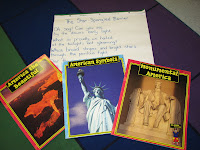I don't know about you, but I have too much to teach and not enough time! I have found that the only way to get it all in is to integrate as much as possible. Social Studies is the most logical subject to integrate into the reading curriculum (although Science works out well sometimes).
This is what I always hear but no one ever explains how to effectively integrate the two. It's more than just reading a Social Studies text as your Daily 5 mini-lesson. You have to use strategies in that text. This lesson is one that I have found the students love because it includes singing. I'm able to pull accuracy, comprehension, and fluency mini-lessons out of one text. After the mini-lesson I have clips of the students working together in their poetry folders. I also included what I use after that when I meet with small groups that need to focus on some of our phonics sounds to review. You can use the same text for whole group, independent / partner work, and small group teaching. It doesn't have to be something new all the time. If you pick your text well you can milk it for all it's worth - okay I'm stepping off my soap box.
Like I mentioned, Social Studies seems to lend itself well to being integrated into Daily 5. The video above shows a mini-lesson and some student practice. I also have some photos below of other ways to tie a United States unit into Daily 5.
Here are some big books I use during Social Studies and also Daily 5 mini-lessons. These books are from Big Books by George. I love them because you can get a big book, small book, and CD. So we might read a page from American Symbols about the Statue of Liberty during a Daily 5 mini-lesson. Then I would ask the students what else they know about the Statue of Liberty and we would discuss how their Schema helped them understand this book better. I hope that makes sense to take the Social Studies concept but pull it into a reading mini-lesson.
These pictures are of my Listen to Reading options after we have been in the United States unit for a while. The students have already heard several of these books during the Social Studies lessons but now are getting another chance to listen to them during Daily 5.
This is the poster I use to teach when I have students point out phonics rules we have learned. I can then use this same poster with a small group. I have chosen certain rules that I think my small group might need to work on and covered those words. We can then discuss them and use the phonics in authentic text.
Here is my Pledge to the American Flag Word Work part of Daily 5. We know the Pledge because we recite it each morning. However, it is not until later in the year (the US unit is around January / February for us) that I put this into Word Work. This seems to be a better time for the students to actually be able to work with the words because they have a better grasp of reading at this point in the year. I got the words and pictures from LRE.com.
They have a lot of good resources, but if you look at this one you will notice I do not use the resource in a lesson like they have on the website. I take things and work them into the framework I already have set up in my classroom.






